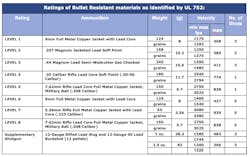Ballistic Glazing: Windows and Doors Designed for Security and Protection
With concerns about domestic and overseas terrorism, increased gun ownership and carrying, and the prevalence of gun use in crimes, more building teams are incorporating ballistics knowledge into their design and construction competencies. In particular, practitioners need to know how ballistic rounds and threat types impact the specification, installation and operation of glazing systems. For certain building types and end-users, knowledge of ballistics performance for fenestration systems is vital — from schools and financial institutions to government buildings and high-end retailers.
Today, windows and doors can be engineered with frames and glazing that are highly resistant to expected threats. Laminated glazing products have been developed with laminates consisting of multiple plies of glass and sometimes with acrylic or polycarbonate panels, all bonded together with interlayers of polyurethane or other formulations. Employing one of the most referenced test standards, Underwriters
Laboratories (UL) 752, glazing laminators can determine the minimum thickness required for a given application or desired performance, which may be 3/4 inch or 3/8 inch, for example, to achieve the minimum protection rating of Level 1 for the resulting ballistic-rated glazing laminates. These transparent panels are designed to repel three rounds from a .9mm handgun.
Most building teams are familiar with glass interlayer products used for typical safety and security glazing, but interlayers for ballistic-resistant glass must achieve a significantly higher level of performance. These strong, sticky formulations such as copolymer polyurethane or thermoplastic polyurethane (TPU) are robust enough to hold together the mass of glass and polycarbonate and acrylic shattered under tremendous force. As a result, the glazing mass becomes a bullet-resisting, protective shield.
When and where is this impressive level of performance required?
Projects teams, led by knowledgeable owner organizations and key consultants, make hazard threat assessments that can be translated into smart design and construction decisions for any individual case. In the United States, most ballistic attacks come from handgun use, with the most likely weapons including .357 Magnum and the aforementioned 9mm models. Overseas, building teams encounter more use of larger weapons, such as the AK-47 assault rifle or the M-16 assault rifle found in greater use in South America. In any case, weapons are often aimed at prominent glass openings of
buildings, where the target of the violence tends to be more visible.
That said, what do building teams need to understand in the area of ballistics? To develop their general ballistic knowledge, building teams could start by considering the term ‘bulletproof.” What does this mean, exactly? The fact is, there is no such thing as a bulletproof building assembly. There are many different kinds of bullets, or ammunition projectile rounds, and they are made with different weights and designed for traveling at specified velocities. In this way, they correspond to varying levels of threat, impact and force. Understanding those is the key to interpreting key standards and ratings that inform building application choices.
READ MORE BY CLICKING 'DOWNLOAD PDF NOW' BUTTON BELOW...

